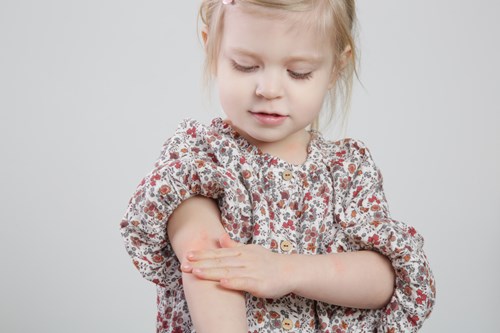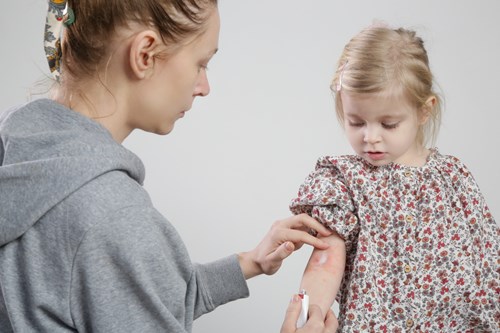Eczema
This month, our blog will consider the skin condition Eczema. The word ‘Eczema’ comes from the Greek word ‘to boil’ which refers to the symptoms sometimes associated with the skin condition. Eczema is a non-contagious, inflammatory dry skin condition that can affect people from early infancy to old age. It can be an incredibly uncomfortable condition for those who have it and can require very careful ongoing management to ensure the affected areas do not worsen. In some cases, the words eczema and dermatitis are used interchangeably however eczema is technically one of many subcategories of dermatitis.

Eczema can start later in life; someone does not have to have had it as a child to develop it as an adult. Eczema is not contagious and therefore cannot be spread from person to person. National Eczema Association shares that there are seven types of eczema which are commonly referred to. Each of these has various triggers or irritants which can trigger a ‘flare-up’ for someone as well as linked conditions which can worsen existing symptoms. A person can have multiple types of eczema on their body at the same time.
As discussed with types of asthma last month, knowing which type of a condition someone has can help to manage exposure to triggers and minimise any symptoms they may experience. Below are the seven types of eczema:
- Atopic eczema: the most common form of eczema and affects 1 in 5 children and 1 in 10 adults in the UK. Although atopic eczema can affect any part of the body though it most often affects the hands, insides of the elbows, backs of the knees and the face and scalp in children. People with atopic eczema usually have periods when symptoms are less noticeable, as well as periods when symptoms become more severe (flare-ups).
- Contact or allergic contact eczema: this form of eczema is brought on by environmental triggers or substances. Reducing exposure to the irritant will usually help the affected area to heal and avoid reoccurrence.
- Neurodermitis or discoid eczema: this form affects small patches of skin and can cause them to be itchy or scaly. Scratching can make them itch more and cause the irritation to develop further. It is typically on the neck, wrists, forearms, legs or groin areas.
- Pompholyx or dyshidrotic eczema: this type of eczema dries out the skin and can cause a burning sensation, rashes and blisters. It usually affects the hands or feet and can last for 2-3 weeks at a time.
- Nummular or discoid eczema: also called nummular dermatitis, this form creates small, rounded lesions all over the body, but especially on arms and legs. The affected areas often start at spots which then join up to be oval in shape and can last for a long period of time if not treated.
- Seborrheic dermatitis: this is an inflammatory form of eczema which affects the scalp. It can cause a variety of symptoms from dandruff to a rash on the affected area.
- Stasis dermatitis: a skin discoloration on the legs or ankles which looks similar to varicose veins. Because poor blood flow usually develops in the lower legs, stasis dermatitis often appears near the ankles.
Signs and symptoms
As detailed above, the signs and symptoms of each type of eczema will vary. It will depend on person to person how exactly the condition presents itself however common characteristics include:
- Dry, cracked skin,
- Itchiness,
- Rash on swollen skin,
- Small, raised bumps,
- Oozing and scabbing,
- Thickened skin,
- Darkening of the skin around the eyes,
- Raw, sensitive skin from scratching.
Treatment
Atopic eczema is the most common type of eczema in children, often developing by a child’s first birthday (NHS). This condition can be irritated further by dry skin, often caused by damage to the skin barrier meaning the skin cannot retain the moisture it needs. The skin barrier is upper most layer of skin that protects irritants, bacteria/viruses, and allergens from getting into our bodies and moisture from getting out. Genes, skin trauma such as from scratching or rubbing, and inflammation can all contribute to this defective or “leaky” skin barrier in people with eczema.
The most effective way to treat dry skin is to give it the moisture it needs. This might be through the wide range of treatments prescribed by a GP, such as steroid creams, moisturising creams, barrier creams, specialist soaps, antihistamines, immunosuppressants, trigger avoidance or bathing in lukewarm water. For children, they may be issued with an Eczema Care Plan. This will detail any alterations which may need to be made to usual provisions, such as using specialist soaps or creams.
The National Eczema Society has a guidance website for families to obtain information around eczema, including tips broken down by age range.

Associated conditions
There are a range of conditions which are often comorbidly linked (they commonly are found together) to eczema or dermatitis.
About 20% of adults with atopic dermatitis also have asthma (if you want to know more about asthma please see last month’s blog). For chidlren, this may present as breathing difficulties when exposed to some of the triggers of asthma or higher occurrences of bronchitis and/or croup.
Up to 15% of children aged 3-18 months with have an allergy to one or more types of food while also having eczema. The most common food allergies in children are milk, eggs, peanuts, wheat and soy. As well as food allergies, allergic rhinitis is a common occurrence alongside eczema. This is commonly known as hayfever, allergies to dust mites and/or pet fur.
Due to problems with the skin barrier and an increase of bacteria on the skin, people with eczema are also prone to skin infections from both bacteria and viruses, especially staph infections.
For further guidance and information, the following sites may be helpful:
https://www.nhs.uk/conditions/atopic-eczema/
https://nationaleczema.org/eczema/
https://www.gosh.nhs.uk/conditions-and-treatments/conditions-we-treat/eczema/
https://knowyourskin.britishskinfoundation.org.uk/condition/eczema/